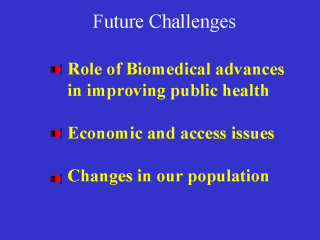|
|
|
|
front |1 |2 |3 |4 |5 |6 |7 |8 |9 |10 |11 |12 |13 |14 |15 |16 |17 |18 |19 |20 |21 |22 |23 |24 |25 |26 |27 |28 |29 |30 |31 |32 |review |
 |
Relatively large increases in cost for vaccines and antibiotics have
implications for the financing of our health care system, for equity issues in
the U.S. and for worldwide benefits of biotech advances.
We also need to consider the changes occurring around us as we progress through the first decades of the next century. We will be an older society. According to the Census Bureau’s projections, the elderly population will more than double between now and 2050, to 80 million. At that point, as many as 1 in 5 Americans could be elderly. And that’s just defining those 65 and over as elderly. The “oldest old” – those aged 85 and above – are the most rapidly growing elderly age group. The baby boom survivors will number 19 million in 2050 – making us 24 percent of elderly Americans and 5 percent of all Americans. This has dramatic health and social implications, if we can expect to live 17 more years once we reach the age of 65. We also will be an increasingly ethnically diverse society with a larger Latino proportion of our population. The Latino population has grown faster than the overall U.S. population since 1990, and is projected to become the largest U.S. minority group by 2005. In California, Latinos are likely to become the largest single racial/ethnic group at some point between the years 2014 and 2021. |